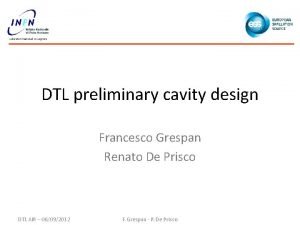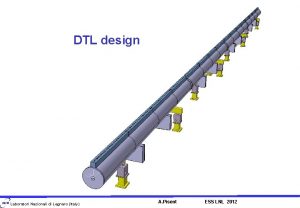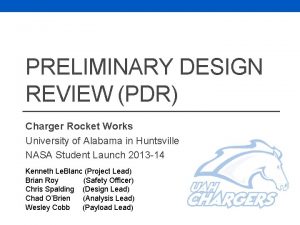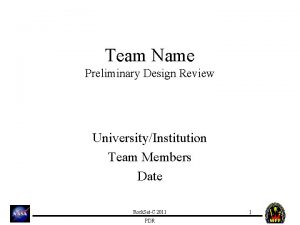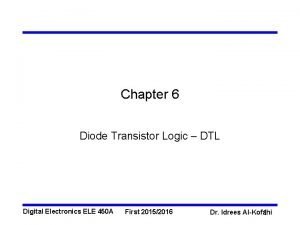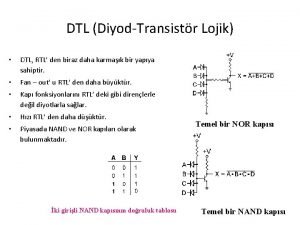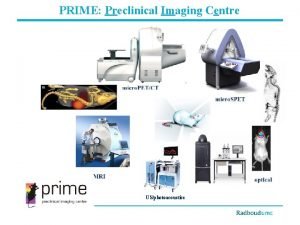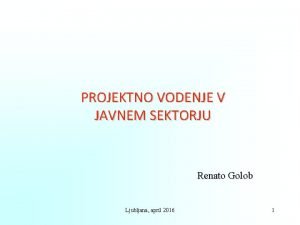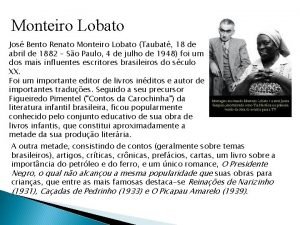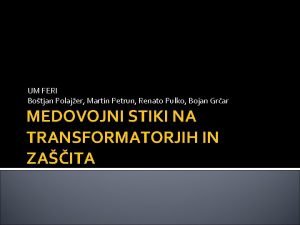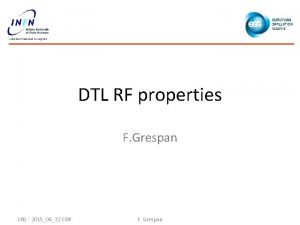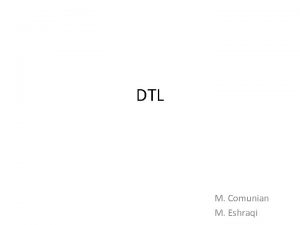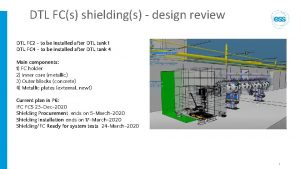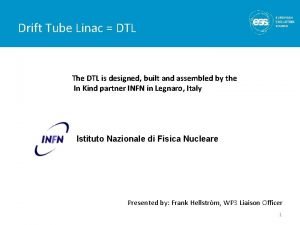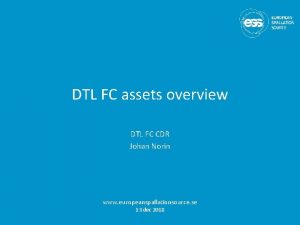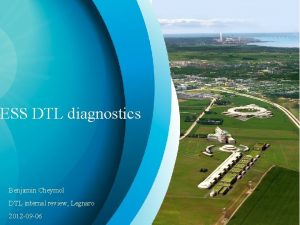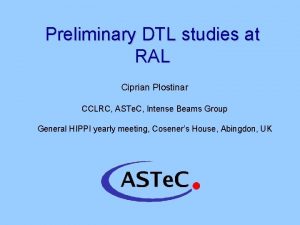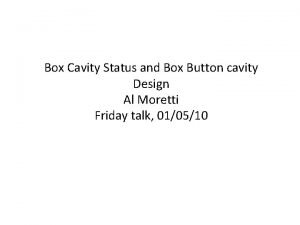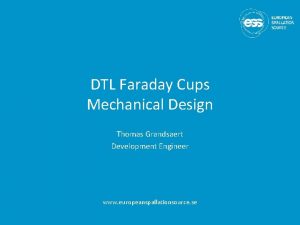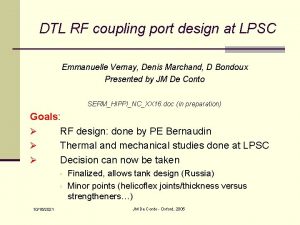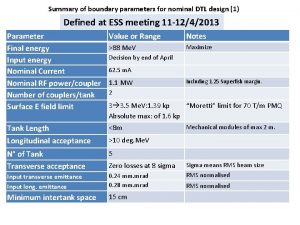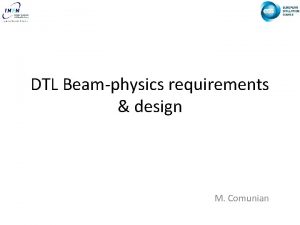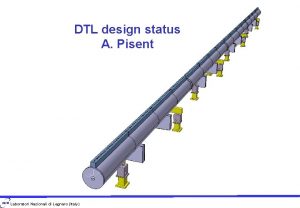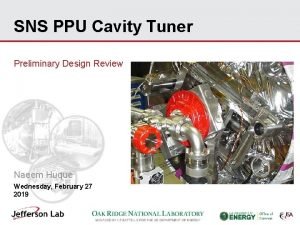DTL preliminary cavity design Francesco Grespan Renato De




![Halbach PMQ Br is the remanence [T] k = 3 for quadrupoles ϑ = Halbach PMQ Br is the remanence [T] k = 3 for quadrupoles ϑ =](https://slidetodoc.com/presentation_image_h/12e04461cc03acb3a4cd8b131cba5b70/image-5.jpg)












![Frequency budget: summary Static frequency budget f 0 [MHz] d. F_post [MHz] d. F_stem Frequency budget: summary Static frequency budget f 0 [MHz] d. F_post [MHz] d. F_stem](https://slidetodoc.com/presentation_image_h/12e04461cc03acb3a4cd8b131cba5b70/image-18.jpg)




- Slides: 22

DTL preliminary cavity design Francesco Grespan Renato De Prisco DTL AIR – 06/09/2012 F. Grespan - R. De Prisco

Contents • • • Main parameters and constraints Peak electric field limitation From cells to tanks RF design Tank properties Post coupler stabilization Frequency budget and tuners DTL AIR – 06/09/2012 F. Grespan - R. De Prisco

Parameters and constraints • Energy: 3 -77 Me. V in 4 tanks, total length = 32 m • Power: – 1 klystron of 2. 8 MW per tank, duty cycle = 4% – Power at RF tank input = 2. 15 MW (30% margin for WG losses and LLRF) – 2. 15 MW > Pcopper × 1. 25 + Pbeam (Ibeam = 50 m. A, 1. 25 margin on Superfish computation) – 2 power couplers per tank, Peak power = 1 MW each • • E 0 linearly ramped in Tank 1 from 2. 8 MV/m to 3. 2 MV/m E 0 = 3. 16 MV/m in Tank 2 -3 -4 PMQ: diameter=60 mm, lengths = 45 mm and 80 mm Esurface < 1. 4 Ek(Ek=18. 4 MV/m) DTL AIR – 06/09/2012 F. Grespan - R. De Prisco

Peak electric field • Enhancement of sparking risk in presence of magnetic field • A. Moretti et al. : fit of measurements of RF breakdown thresholds in a 805 MHz cavity in the presence of a dc magnetic field. Assumption of scaling with Kilpatrick criterion (Mu. Cool program at Fermi. Lab) • • LANL 425 MHz DTL Los Alamos 425 MHz DTL and Linac 4 DTL show quadrupolar pattern of the PMQ fringing field (one point or two points multipacting? ) DTL AIR – 06/09/2012 F. Grespan - R. De Prisco Linac 4 352 MHz DTL
![Halbach PMQ Br is the remanence T k 3 for quadrupoles ϑ Halbach PMQ Br is the remanence [T] k = 3 for quadrupoles ϑ =](https://slidetodoc.com/presentation_image_h/12e04461cc03acb3a4cd8b131cba5b70/image-5.jpg)
Halbach PMQ Br is the remanence [T] k = 3 for quadrupoles ϑ = angle of the Sm. Co blocks PMQ dimensions: • outer diameter = 60 mm • bore diameter = 22 mm • steel jacket thickness = 0. 5 mm • rectangular block sizes = 4 mm x 14 mm DTL AIR – 06/09/2012 F. Grespan - R. De Prisco

Peak electric field • • • 3 D simulation of 1 st ESS-DTL cell, with Halbach PMQ inside the tube. PMQ Gradient=70 T/m, PMQ Length=45 mm. Maximum surface field is at R=12 mm. At that point, for the 1 st cell, B = 0. 092 T → Elimit =1. 45 Ekilp (design = 1. 38 Ekilp) Risk of multipacting reduced by avoiding parallel surfaces Magnetic flux density B (T) ESS SNS Linac 4 DTL AIR – 06/09/2012 F. Grespan - R. De Prisco E (V/m) and B (T) on drift tube surface

From cells to tanks RF design Main cell parameters • DT diameter = 90 mm • Rc = 5 mm • Ro = 8 mm • Ri = 3 mm • Rb = 10/10/11/12 mm (T 1/T 2/T 3/T 4) • F = 7/5/5/4 mm (T 1/T 2/T 3/T 4) • Tank diameter = 520 mm • Gap and cell length from beam dynamics DTL AIR – 06/09/2012 F. Grespan - R. De Prisco

From cells to tanks RF design 1. 2. 3. 4. 5. 6. Beam dynamics use Superfish runs of single cells (E 0, T, ZTT, Energy gain) Beam dynamics inputs to RF design: E 0, Sync. Phase law, Number of Cells, Cell and Gap lengths, Guess value of Face Angle af Stem perturbation compensated by Face Angle Tank composition by all cells resonant at the same frequency Adjust Face Angles to obtain desired field: ramping and fine field adjusting Check of geometrical feasibility (PMQ space) and energy gain and sync. phase law. From 2 to 6 done by Matlab routine running Superfish DTL AIR – 06/09/2012 F. Grespan - R. De Prisco

3 D simulation • • • Design procedure validated in a representative tank (5. 5 m, 26 cells) with aggressive ramped field 1100000 tetrahedra (revolution swept, similar to Superfish) Max error E 0 = 4% located in the two end cells (used for ramping) DTL AIR – 06/09/2012 F. Grespan - R. De Prisco

Tank properties Parameter/Tank 1 2 3 4 Cells 66 36 29 25 2. 8, 3. 2 3. 16 1. 43 1. 39 1. 37 -35, -24 -24 -8 -8 -8 -6 Tank length [m] 7. 95 (9. 3 l) 7. 62(8. 9 l) 7. 76(9. 1 l) 7. 72(9. 0 l) Q 0 (no margins) 53000 4 56000 4 55000 4 Peak power on copper [MW] 0. 91 0. 92 0. 95 Beam output energy [Me. V] 21. 4 41. 0 60. 0 77. 7 Peak RF power (1. 25 margin) [MW] 2. 06 2. 12 2. 10 2. 07 E 0 [MV/m] Max. Surface Field [Emax/Ek] Synch. Phase [deg] End tank phase matching [deg] N° of mech. Modules DTL AIR – 06/09/2012 F. Grespan - R. De Prisco

Tank subdivision First module tank 1 at 1997 mm → cell 24, cell length=101. 3 mm, E out=7. 08 Me. V DTL AIR – 06/09/2012 F. Grespan - R. De Prisco

Post couplers DTL stabilization or compensation against geometric errors (manufacturing, deformation), phase shift (wall losses), transients (beam loading) How many post couplers? • Post Couplers can stop the propagation of the field perturbation: when the perturbed E 0 meets a welltuned post coupler, E 0 jumps to the nominal value. • Post Couplers must keep E 0 within specifications (± 1%) in case of a reasonable perturbation of the endcells. • Cell 1 of Tank 1 is the most sensitive to perturbation. DTL AIR – 06/09/2012 F. Grespan - R. De Prisco

Post couplers How many post couplers? • DTL is described by a circuit model (C 0 = average gap capacitance, C = DT – tank average capacitance, Cp and Lp= post coupler elements) • Circuit with average values reproduces E 0 tilt for a given gap perturbation • For a given error on C 0, longer cells introduce a larger E 0 tilt • d. Gap=-0. 3 mm for all tanks with sensitivity of Cell 1 -Tank 1 DTL AIR – 06/09/2012 F. Grespan - R. De Prisco

Post couplers Parameter/Tank 1 2 3 4 N cells 66 36 29 25 0. 33 0. 35 0. 32 N PCs 22 23 28 24 N PCs / N cells 1/3 first 1/2 end 1/1 1/1 Detuning [MHz] + 0. 17 +0. 20 +0. 17 Power [MW] + 0. 031 0. 036 0. 044 0. 031 PC distance [m] DTL AIR – 06/09/2012 F. Grespan - R. De Prisco

Frequency budget: errors • • • Tuners compensate construction errors Evaluation with realistic tolerances on important dimensions (tank diameter, drift-tube lengths, drift tube diameter, face angles) Movable tuners compensate thermal deformations in operation Evaluation with thermo-mechanical simulations: 1 st cell of Tank 1 is the most sensitive → taken for all cells as a margin sensitivity Tank 1 -Cell 1 [MHz/mm] machining error [mm] dynamic static freq dynamic freq error [mm] error [MHz] d_tank -0. 45 ± 0. 100 0. 010 ± 0. 045 0. 005 d_DT 0. 6 ± 0. 025 0. 020 ± 0. 015 0. 012 gap 5. 6 ± 0. 025 0. 007 ± 0. 140 0. 039 face_angle 5. 8 ± 0. 025 0. 003 ± 0. 145 0. 017 d_stem -0. 136 ± 0. 025 0. 01 ± 0. 003 0. 001 Sum ± 0. 348 Total [MHz] DTL AIR – 06/09/2012 F. Grespan - R. De Prisco 0. 075 0. 405

Thermo-mechanical simulation Laminar flow DTL AIR – 06/09/2012 Tank 2 - cell 1 Turbulent flow Tank 1 - cell 1 Simulation input: • Power density = 5% · Rs/2 · (E 0/1 · H)2 • Inlet stem water= 3 m/s, convective transfer coefficient h= 10000 • drift tube water=1 m/s, convective transfer coefficient h= 600 F. Grespan - R. De Prisco Cooling for tubes of Tank 2 -3 -4 should be reviewed

Frequency budget: tuners Tuner sensitivity obtained form 3 D simulation of 1 tuner over half a cell (symmetries!) Tuners at 45° with respect to the stem axis. Tuner sensitivity = 0. 0035 (MHz/mm) x m DTL AIR – 06/09/2012 F. Grespan - R. De Prisco
![Frequency budget summary Static frequency budget f 0 MHz d Fpost MHz d Fstem Frequency budget: summary Static frequency budget f 0 [MHz] d. F_post [MHz] d. F_stem](https://slidetodoc.com/presentation_image_h/12e04461cc03acb3a4cd8b131cba5b70/image-18.jpg)
Frequency budget: summary Static frequency budget f 0 [MHz] d. F_post [MHz] d. F_stem [MHz] d. F_static errors (20%margin) [MHz] f_Superfish_Target [MHz] 352. 2 0. 17 1. 3 0. 5 350. 2 Tuning range length [m] tuner_sens [(MHz/mm) x m] Tuners/m Ntuners Nominal penetration [mm] 7. 95 0. 00356 3 24 46. 5 Dynamic tuning range dynamic range tank [MHz] Ntuners_movable_tank Movable_Tuners_Stroke [mm] ± 0. 07 3 ± 52. 1 CERN design DTL AIR – 06/09/2012 F. Grespan - R. De Prisco

Thank you! DTL AIR – 06/09/2012 F. Grespan - R. De Prisco

DTL AIR – 06/09/2012 F. Grespan - R. De Prisco

DTL AIR – 06/09/2012 F. Grespan - R. De Prisco

DTL AIR – 06/09/2012 F. Grespan - R. De Prisco
 Thoracic cavity
Thoracic cavity Francesco grespan
Francesco grespan Dtl design
Dtl design Imaginary line through body
Imaginary line through body The abdominal cavity is to the thoracic cavity
The abdominal cavity is to the thoracic cavity What is the transverse mesocolon
What is the transverse mesocolon Peritoneum,
Peritoneum, Preliminary design review example
Preliminary design review example Pdr preliminary design review
Pdr preliminary design review Preliminary design review example
Preliminary design review example Carrying value formula
Carrying value formula Fas 109 and fin 48
Fas 109 and fin 48 Modified dtl
Modified dtl Dtl dol dfl
Dtl dol dfl Dtl nand
Dtl nand Dtl prime
Dtl prime Renato golob
Renato golob Renato bukovac
Renato bukovac Ralph lobato
Ralph lobato Jose abelardo barbosa
Jose abelardo barbosa Thiago possui 3 blusas diferentes e 2 calças diferentes
Thiago possui 3 blusas diferentes e 2 calças diferentes Renato de filippo
Renato de filippo Martin petrun
Martin petrun

